Electricity Class 10 MCQs Questions with Answers
Question 1.
The values of mA and µA are:
(a) 10-6 and 10-9 A respectively
(b) 10-3 and 10-6 A respectively
(c) 10-3 and 10-9 A respectively
(d) 10-6 and 10-3 A respectively
Answer:
(b) 10-3 A and 10-6 A.
Explanation: An ampere is the SI unit of electric current
1A = 1000mA Or 1mA = \(\frac{1 \mathrm{~A}}{1000}\) = 103A
∴ 1 µA = 10-3 × 10-3 A = 10-6A
Question 2.
A cylindrical conductor of Length ‘l’ and uniform area of cross-section ‘A’ has resistance ‘R’. Another conductor of Length 2.5 1 and resistance 0.5 R of the same material has area of cross-section.
(a) 5A
(b) 2.5A
(c) 0.5A
(d) \(\frac{1}{5}\) A
Question 3.
Identify the circuit in which the electrical components have been properly connected.
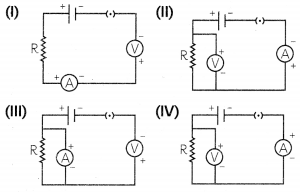
(a) (I)
(b) (II)
(c) (III)
(d) (IV)
Answer:
(b) (II)
Explanation: In figure (I), the voltmeter is connected in series (not parallel). Similarly, in figure (III). the ammeter ¡s in parallel which should be in series. In figure (IV), the negative terminal of battery has been connected to the positive terminal of the ammeter, whereas it should be connected to the negative terminal
Related Theory:
Essential conditions when components connected:
- The voltmeter should be connected in parallel
- The ammeter should be connected in series.
- Positive terminals of the voltmeter arid ammeter should be connected to the positive terminal of the cell and their negative removals should be joined to the negative terminal of the cell
Question 4.
If a person has five resistors each of value Ω, then the maximum resistance he can obtain by connecting them ¡s:
(a)1 Ω
(b)5 Ω
(c) 10 Ω
(d) 25 Ω
Answer:
Question 5.
What is the minimum resistance which can be made using five resistors, each of \(\frac{1}{5}\) Ω?
(a) \(\frac{1}{5}\) Ω
(b) \(\frac{1}{25}\) Ω
(c) \(\frac{1}{10}\) Ω
(d) 25 Ω
Answer:
Question 6.
The resistance of a resistor is reduced to half of its initial value. In doing so, if other parameters of the circuit remain unchanged, the heating effects in the resistor will become:
(a) two times
(b) half
(c) one-fourth
(d) four times
Answer:
(a) two times
Explanation: Resistance of a resistor R Q New resistance of a resistor Q
All other parameters of the circuit remain unchanged

By applying Joule’s law of heating H = I2Rt
As per Ohms Law V = IR Or I = \(\frac{V}{R}\)
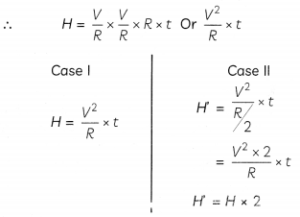
Hence, the heating effect in the resistor will become two times if all other parameter of the circuit remain same.
Question 7.
At the time of short circuit, the electric current in the circuit:
(a) vary continuously
(b) does not change
(c) reduces substantially
(d) increases heavily
Answer:
Question 8.
Two bulbs of 100 Ω and 40 Ω are connected in series. The current through the 100 Ω bulb is 1 A. The current through the 40 Ω bulb will be:
(a) 0.4 A
(b) 0.6 A
(c) 0.8 A
(d) 1A
Answer:
(d) 1 A
Explanation:
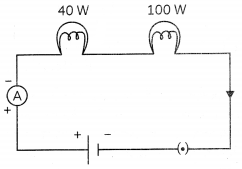
In a series combination of resistors (bulbs) the current is the same in every part of the circuit as current does not change in series combination so both the bulbs get equal amount of current Hence the current through the 40 Ωbulb will be 1A.
Question 9.
When a 4 V battery is connected across an unknown resistor there is a current of 100 mA in the circuit. The value of the resistance of the resistor is:
(a) 4 Ω
(b) 40 Ω
(c) 400 Ω
(d) 0.4 Ω
Answer:
(b) 40 Ω
V = IR, V = 4 V,
I = 100 mA = 0.1 A
Hence R = \(\frac{V}{1}=\frac{4}{0.1}\) Ω = 40 Ω.
Question 10.
The equivalent resistance of a series combination of two resistances is X Ohm. If the resistance are of 10 Ohm and 40 Ohm respectively, the value of X will be:
(a) 10 Ohm
(b) 20 Ohm
(c) 50 Ohm
(d) 40 Ohm [Diksha]
Answer:
Question 11.
Unit of electric power may also be expressed as:
(a) volt-ampere
(b) kilowatt-hour
(c) watt-second
(d) joule-second
Answer:
Question 12.
if the resistance of a certain copper wire is 1 Ω, then the resistance of a similar nichrome wire will be about:
(a) 25 Ω
(b) 30 Ω
(c) 60 Ω
(d) 45 Ω
Answer:
(c) 60 Ω
Explanation: if the resistance of a certain copper wire is 1 Ω, the resistance of a similar nichrome wire will be about 60 Ω because the resistivity of nichrome is 60 times the resistivity of copper.
Question 13.
The resistivity of a certain material is 0.6 Ω m, The material is most likely to be:
(a) an insulator
(b) a superconductor
(c) a conductor
(d) a semiconductor
Answer:
Question 14.
A cell, a resistor, a key, and an ammeter are arranged as shown in the circuit diagrams of the figure. The current recorded in the ammeter will be:
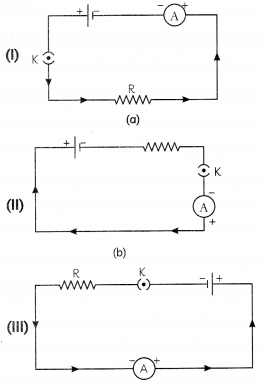
(a) Maximum in (I)
(b) Maximum in (II)
(c) Maximum in (III)
(d) The same in all the cases
Answer:
(d) The same in all the cases
Explanation: In series connections, the order of elements in the circuit will not affect the amount of current flowing in the circuit.
Question 15.
The instrument used for measuring electric current is:
(a) galvanometer
(b) ammeter
(c) voltmeter
(d) potentiometer
Answer:
Question 16.
A student plots V-l graphs for three samples of nichrome wire with resistances R1, R2 and R3. Choose from the following the statement that holds true for this graph.
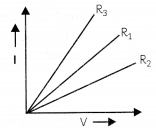
(a) R1 = R2 = R3
(b) R1 > R2 > R3
(c) R3 > R2 > R1
(d) R2 > R1 > R3
Answer:
(d) R2 > R1 > R3
Explanation: As is clear from the graph, the current for A2 conductor is less than A1 and A1 is Less than A3. We can say IA2 < IA1 < IA3
R2 > R1 > R3 (AS, R = V)
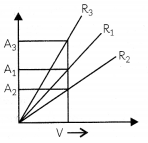
Question 17.
The maximum resistance which can be made using four resistors each of resistance \(\frac{1}{2}\) Ω is:
(a) 2 Ω
(b) 1 Ω
(c) 2.5 Ω
(d) 8 Ω
Answer:
(a) 2 Ω
Explanation: When a number of resistances are connected in series the resultant resistance is equal to the sum of the individual resistances and is greater than any individual resistance. Four resistors are given:
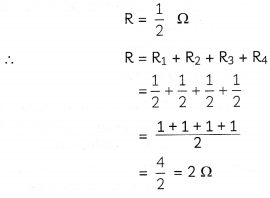
Hence, the maximum resistance which can be made using four resistors each of resistance \(\frac{1}{2}\) Ω is 2 Ω.
Question 18.
A current of 2 A is drawn by a conductor on applying a potential difference of 6 V across its ends. The number of electrons passing through a cross-section of the conductor and the heat generated in the conductor in 8 seconds is:
| Number of Electrons Passing in 8 s | Heat Generated in 8 s |
| (a) 1.6 × 10-20 | 24 J |
| (b) 1020 | 96 J |
| (c) 1.28 × 10-18 | 3.6 × 106 J |
| (d) 1030 | 96 J |
Answer:
Question 19.
The resistivity of four wires A, B, C, and D are of the order of 1012, 10-6, 10-8, and 1014 respectively. !f the wires are of equal lengths and equal areas of cross-section, then select the row containing the correct information:
| Resistance | Nature |
| (a) Resistance of C will be the least | C is the conductor best of electricity |
| (b) Resistance of A will be the largest | A is a good conductor of electricity |
| (c) Resistance of B will be the largest | B is a poor conductor of electricity |
| (d) Resistance of D will be the least | D is the conductor best of electricity |
Answer:
Question 20.
Given below are four statements on-resistance of a conductor. Select the incorrect statements:
(I) If in an electric circuit, the resistance is doubled the voltage also gets doubled.
(II) If in an electric circuit, the resistance is halved the current gets doubled.
(III) Variable resistance is a component used to regulate voltage without changing the current.
Answer:
(b) Both (I) and (III)
Explanation: According to Ohm’s law, V = IR.
Therefore, l = \(\frac{V}{R}\).
It means that if resistance R is doubled, the current gets halved, but the voltage remains the same. Similarly, if resistance is halved, currently gets doubled.
Question 21.
Given below are four statements about resistivity. Select the incorrect statements:
(I) Resistivity is a characteristic property of the material and varies with temperature.
(II) Resistivity depends on the length and area of the cross-section of the conductor.
(III) Metals and alloys have very low resistivity and are good conductors of electricity.
(IV) Insulators have low resistivity of the order of 1012 to 1017 Ohm.
(a) Both (I) and (II)
(b) Both (I) and (III)
(c) Both (II) and (III)
(d) Both (II) and (iV)
Answer:
Question 22.
Select the correct statements from the statements given below:
(I) In a parallel circuit the current is constant throughout the electric circuit.
(II) In a parallel circuit the other components keep working even if one component fails.
(III) In a series circuit when one component fails, the circuit is broken and the other components stop working.
(IV) in a series circuit, the current is divided among the electrical gadgets depending upon their resistance.
(a) Both (I) and (II)
(b) Both (II) and (III)
(c) Both (III) and (IV)
(d) (I), (III), and (IV)
Answer:
(b) Both (II) and (III)
Explanation: In a series circuit, the current is constant through the electric circuit and if one component fails, the other components also stop working. Whereas in a parallel circuit, the current is divided among the different components depending upon their resistance, and if one component fails, the other components keep working.
Question 23.
The unit of potential difference is:
(a) JC
(b) J/C
(c) J
(d) C/J
Answer:
(b)J/C
Explanation: Potential difference between two points in an electric field of a given charge is defined as the work done in moving a unit positive charge from one point to another. As V = \(\frac{W}{q}\) , the unit of potential difference is Joule/ Coulomb or J/C.
Question 24.
If both the length of a conductor and its radius is doubled, the ratio of new resistance and original resistance will be:
(a) 1:1
(b) 2:1
(c) 4:1
(d) 1: 2
Answer:
Question 25.
When a 2 Ω resistor is connected across the terminals of a 6 V battery, the charge (in coulombs) passing through the resistor per second is:
(a) 0.5
(b) 2
(c) 3
(d) 4
Answer:
(c) 3
Explanation: The charge passing through a resistor per second is the same as the current passing through the resistor since current is defined as the rate of flow of charges. The current flowing is found by using Ohm’s law, V = IR. Therefore, I = V/R = 6/2 = 3A, which is the same as the charge passing in one second.
Question 26.
A battery of 6V is connected in series with resistors of 0.1 ohms, 0.2 ohms, 0.3 ohms, 0.4 ohm,s and 2 ohms. How much current would flow through the 0.3-ohm resistor?
(a) 0.895A
(b) 1.2 A
(c) 2 A
(d) 3 A
Assertion Reasoning questions Class 10 Science Chapter 12
For the following questions, two statements are given – One labeled Assertion (A) and the other labeled Reason (R), select the correct answer to these questions from the codes (a), (b), (c), and (d) as given below:
(a) Both (A) and (R) are true and (R) is the correct explanation of the (A).
(b) Both (A) and (R) are true but (R) is not the correct explanation of the (A).
(c) (A) is true but (R) is false.
(d) (A) is false but (R) is true.
Question 27.
Assertion (A): At high temperatures, metal wires have a greater chance of short-circuiting.
Reason (R): Both resistance and resistivity of a material vary with temperature.
Answer:
(b) Both (A) and (R) are true but (R) is not the correct explanation of the (A).
Explanation: At high temperatures, the free electrons start moving at a greater speed and more heat is evolved. The increased amount of heat melt the insulation of wires and wires have a greater chance of short-circuiting. Sometimes the short circuit may even melt the wire and it may cause fire.
Both resistance and resistivity vary with temperature. When the temperature is increased, the random motion of electrons increases. As a result the number of collisions increases between atoms and electrons.
Question 28.
Assertion (A): When two ends of a metallic wire are connected across the terminals of a cell, then some potential difference is set up between its ends. The direction of electrons are from a positive terminal to negative terminal of the cell.
Reason (R): Electrons are flowing through the conductors from its higher potential to its lower potential end. [Diksha]
Answer:
Question 29.
Assertion: A fuse wire is always connected in parallel with the mainline.
Reason: If a current larger than the specified value flows through the circuit, fuse wire melts.
Answer:
Question 30.
Assertion(A): Electric appliances with the metallic body have three pin connection, whereas an electric bulb has a two pin connection.
Reason (R): Three pin connection reduce heating of connecting wires. [Diksha]
Answer:
(c) (A) is true but (R) is false.
Explanation: The three connection of electric appliances with metallic body are live wire, neutraL wire and earth wire. The live and neutraL wire supply electric current to the appliance, whereas the earth wire, which is connected to the metal body of the electric appliance, protects us from electric shock in case we touch the metal body of appliances.
In case of an electric shock, the current passes directly to the earth through the earth wire and we do not feel the electric shock.
On the contrary, three-pin connection do not reduce heating of connecting wires.
Question 31.
Assertion (A): In a purely resistive circuit, the source energy is dissipated in the form of heat.
Reason (R): The potential difference across the ends of a conductor is directly proportional to the current flowing through it.
Answer:
Question 32.
Assertion (A): Alloys are commonly used in electrical heating devices like electric ion and heater.
Reason (R): Resistivity of an alloy is generally higher than that of its constituent metals but the alloys have low melting points then their constitutent, metals. [CBSE 2020]
Answer:
(a) Both (A) and (R) are true and (R) is correct explanation of the assertion.
Related Theory
Alloys have more resistivity than of its constituent elements because alloys have better properties than that of metals. Resistivity is the property of a material that explains how strongly the material opposes flow of electrons. Higher the resistivity, smaller will be the conductivity i.e. why alloys are used in electrical heating devices.
Metals have a higher melting point as the atoms are arranged in a regular manner and form a strong bond whereas alloys are made up of different metals. The different sizes of atoms in an alloy make their arrangement less regular than a pure metal. This makes the bonds between the atoms weaker and lowers the melting point.